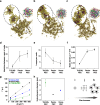Bridge-rich and loop-less hydrogel networks through suppressed micellization of multiblock polyelectrolytes
- PMID: 39095421
- PMCID: PMC11297175
- DOI: 10.1038/s41467-024-50902-z
Bridge-rich and loop-less hydrogel networks through suppressed micellization of multiblock polyelectrolytes
Abstract
Most triblock copolymer-based physical hydrogels form three-dimensional networks through micellar packing, and formation of polymer loops represents a topological defect that diminishes hydrogel elasticity. This effect can be mitigated by maximizing the fraction of elastically effective bridges in the hydrogel network. Herein, we report hydrogels constructed by complexing oppositely charged multiblock copolymers designed with a sequence pattern that maximizes the entropic and enthalpic penalty of micellization. These copolymers self-assemble into branched and bridge-rich network units (netmers), instead of forming sparsely interlinked micelles. We find that the storage modulus of the netmer-based hydrogel is 11.5 times higher than that of the micelle-based hydrogel. Complementary coarse grained molecular dynamics simulations reveal that in the netmer-based hydrogels, the numbers of charge-complexed nodes and mechanically reinforcing bridges increase substantially relative to micelle-based hydrogels.
© 2024. The Author(s).
Conflict of interest statement
The authors declare no competing interests.
Figures




References
LinkOut - more resources
Full Text Sources

